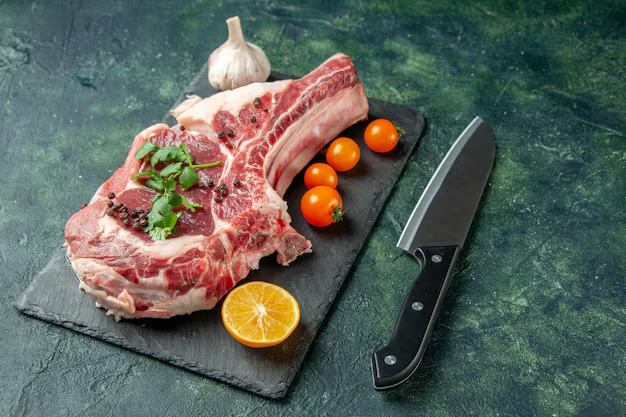How Long Can You Keep Raw Steak in the Fridge? Your Guide to Optimal Freshness
Ever come home from the grocery store, excited to cook a savory steak dinner, only to realize you might not get to it as soon as you hoped? A common scenario, yet one that leads to an essential question: How long is raw steak good in the refrigerator? Navigating the world of food storage can be tricky, especially when the safety of your meal is at stake. Let's dive into the details and ensure your steak is both safe to eat and delicious.
🥩 Understanding the Shelf Life of Raw Steak
Storing steak improperly or for too long can affect its taste and, more importantly, its safety. Generally, raw steak stored in the fridge is good for three to five days. These days can vary based on factors such as the steak's cut and how fresh it was when purchased. Here's what you need to know to keep your meat safe:
Factors Influencing Raw Steak's Shelf Life
- Cut of the Steak: Larger cuts like roasts tend to last longer in the fridge compared to smaller cuts like ribeye or sirloin.
- Freshness at Purchase: Always check the packaging date and purchase steak as fresh as possible.
- Refrigerator Temperature: Keeping your fridge at or below 40°F (4°C) is crucial in maintaining steak's freshness.
- Packaging: Airtight wrapping can prolong freshness by preventing exposure to air and contaminants.
The Importance of Proper Packaging
Proper storage begins at the grocery store. Look for vacuum-sealed packages or fresh cuts wrapped tightly in plastic wrap. If re-wrapping at home, opt for airtight containers or zip-lock bags. Vacuum sealing is an excellent method for extending the life of your steak by removing air from the packaging, thus reducing the risk of bacterial growth.
Recognizing Spoilage: When to Bid Adieu
Knowing the signs of spoilage can protect you from potential food poisoning and ensure only the best flavor in your meals. Here are some clear indicators that your steak may have overstayed its welcome:
Key Signs of Spoiled Steak
- Odor: A sour, ammonia-like smell is a strong giveaway of spoilage.
- Color: Fresh steak is usually a bright red. A brown or grayish color can indicate spoilage.
- Texture: Slimy, sticky texture is a definite sign to discard the meat.
- Mold: Any visible mold growth means it’s time to let the steak go.
Best Practices: Getting the Most Out of Your Steak
While keeping steak safe in the fridge involves basic care, understanding the nuances of meat storage can help you extend its life without compromising on quality.
🧊 Refrigeration Tips for Raw Steak
- Mind the Temperature: Keep your refrigerator's temperature consistent to prevent bacteria.
- Quick Access: Store steak in the coldest part of the fridge, typically the bottom or back shelves.
- Do Not Cross-Contaminate: Keep separate drawers for meats to avoid cross-contamination with other foods.
The Freezing Option: When It's Not Yet Time to Cook
When you're unsure about cooking your steak within three to five days, freezing is a viable option. It can extend the life of your raw steak for up to six months without a significant loss of quality.
Tips for Freezing Steak
- Pre-Freeze Preparation: Before freezing, wrap your steak with plastic wrap or aluminum foil tightly, followed by placing it in a freezer-safe bag.
- Labeling: Always label packages with the date of freezing to keep track of how long it's been stored.
- Thawing: When ready to use, thaw your steak safely in the fridge rather than on the countertop to prevent bacterial growth.
🗒️ Quick Reference Summary Table
Raw Steak Storage and Shelf Life
| Action | Recommended Practice |
|---|---|
| Fridge Storage | Store for 3-5 days |
| Optimal Fridge Temperature | Keep at ≤ 40°F (4°C) |
| Wrapping | Use airtight containers or vacuum seal |
| Signs of Spoilage | Smell, color change, texture, mold |
| Freezing Duration | Store for up to 6 months |
| Freezing Prep | Airtight wrapping, label with date |
| Thawing Method | Defrost in refrigerator |
Rethinking Steak Buy and Storage Habits
The art of steak storage extends far beyond merely placing meat in the fridge. By thoughtfully considering how and when to buy and store your steak, you can ensure that each meal you prepare is delicious and safe for consumption.
🛒 Smart Shopping Tips
- Shop Fresh: Select the freshest steak you can find with the latest sell-by date.
- Plan Meals: When meal planning, account for all fresh items, so they don't go to waste.
- Check Storage at Purchase: Inspect packaging for tight seals and no damage.
Cooking with Confidence: Enjoying Your Stored Steak
You've successfully stored and potentially thawed your steak—now comes the best part: cooking it. Whether you prefer grilling, pan-searing, or broiling, ensuring your steak is cooked to the right temperature is key to food safety and taste.
🍲 Cooking Tips for Best Steak Experience
- Right Temperature: Use a meat thermometer to ensure the internal temperature reaches at least 145°F (63°C).
- Resting: Allow the steak to rest after cooking for juicier, more flavorful meat.
- Pairing: Complement your steak with appropriate sides for a balanced meal.
In summary, managing the freshness of raw steak in your refrigerator is both an art and a science. By understanding the fundamentals of storage, recognizing spoilage signs, and practicing smart shopping, you can fully enjoy the steakhouse experience right at home. 🏠🍽️
Remember, when in doubt about your steak's freshness, it's better to be safe than sorry. Follow these guidelines to keep food safety as the top priority and keep your taste buds delighted.
